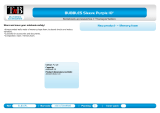
1 Product description
Category Description
Product name HP Notebook PC
HP 250 G4 Notebook PC
HP 256 G4 Notebook PC
Processors 5th generation Intel® Core™ i7 processor
Intel Core i7-5500U (2.4-GHz, turbo up to 3.0 GHz, 4-MB L3 cache, 1600-MHz, dual, 15W)
5th generation Intel Core i5 processor
Intel Core i5-5200U (2.2-GHz, turbo up to 2.7 GHz, 3-MB L3 cache, 1600-MHz, dual, 15W)
5th generation Intel Core i3 processor
Intel Core i3-5020U (2.2-GHz, 3-MB L3 cache, 1600-MHz, dual, 15W)
Intel Core i3-5010U (2.1-GHz, 3-MB L3 cache, 1600-MHz, dual, 15W)
Intel Core i3-5005U (2.0-GHz, 3-MB L3 cache, 1600-MHz, dual, 15W)
4th generation Intel Core i3 processor
Intel Core i3-4005U (1.7-GHz, 3-MB L3 cache, 1600-MHz, dual, 15W)
Intel processor
Intel Core i7-4510U (2.0-GHz, turbo up to 3.10 GHz, 4-MB L3 cache, 1600-MHz, dual, 15W)
Intel Core i7-4210U (1.7-GHz, turbo up to 2.70 GHz, 3-MB L3 cache, 1600-MHz, dual, 15W)
Intel Pentium® N3825U (1.9-GHz, 2-MB L3 cache, 1600-MHz, dual, 15W)
Intel Pentium N3700 (1.6-GHz, turbo up to 2.4 GHz, 2-MB L3 cache, 1600-MHz, quad, 6W)
Intel Pentium N3540 (2.16-GHz, turbo up to 2.66 GHz, 2-MB L2 cache, 1333-MHz, quad, 7.5W)
Intel Celeron® N3150 (1.66-GHz, turbo up to 2.08 GHz, 2-MB L3 cache, 1600-MHz, quad, 6W)
Intel Celeron N3050 (1.66-GHz, turbo up to 2.1 GHz, 2-MB L3 cache, 1600-MHz, dual, 6W)
Chipset Intel Wildcat Point-LP PCH (Intel BDW U processor 1-chip BGA)
Intel Lynx Point-LP PCH (Intel HSW U SoC processor)
Intel Braswell SoC (Intel Braswell)
Intel BayTrail-M
Graphics Internal graphics:
Intel HD Graphics 5500 (Intel BDW U series)
Intel HD Graphics 4400 (Intel HSW U series)
Intel HD Graphics (Intel Braswell)
Switchable discrete graphics:
AMD Radeon™ R5 M330 (Exo PRO) with up to 1024 MB of dedicated video memory (128Mx16 DDR3 900MHz
x 4 PCs, 1GHz bridge to 900MHz), TDP 18W
1




















